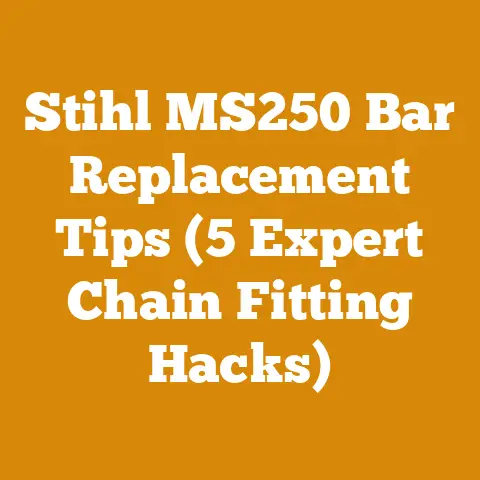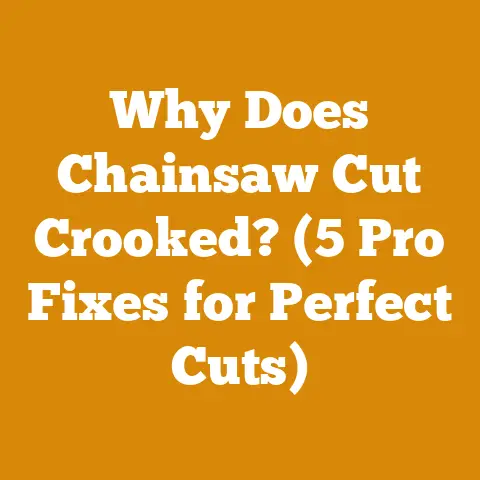Brush Hog Weed Eater Tips for Thick Brush Cutting (Pro Arborist Guide)
Imagine standing at the edge of your property, a vast expanse of overgrown brush stretching before you.
Sunlight glints off the thick stalks of weeds, the unruly saplings, and the tenacious vines that threaten to reclaim every inch of your land.
You envision a neat, usable space, a sanctuary carved from the chaos.
This is where the real work begins, and it’s where a “brush hog,” often used interchangeably with “rotary cutter” or even a heavy-duty “weed eater,” becomes your indispensable ally.
But before you rev up that engine, let’s dive into the world of brush hogging, understand its true costs, and learn how to wield it like a seasoned pro – all while keeping your budget firmly in check.
Brush Hog Weed Eater Tips for Thick Brush Cutting (Pro Arborist Guide)
As a seasoned arborist, I’ve spent countless hours battling thick brush, reclaiming neglected land, and transforming overgrown areas into manageable landscapes.
Over the years, I’ve learned that effective brush hogging isn’t just about brute force; it’s about strategy, technique, and a deep understanding of your equipment and the challenges at hand.
This guide is designed to equip you with the knowledge and skills you need to tackle even the most daunting brush-clearing projects, all while keeping your costs manageable.
Understanding the Brush Hog Landscape: Defining Terms and Expectations
First, let’s clarify what we mean by “brush hog” and its relation to other tools.
While “weed eater” typically refers to a string trimmer for light-duty grass and weed trimming, a brush hog (rotary cutter) is a much more robust piece of equipment designed for cutting through thick vegetation, saplings, and even small trees.
Some high-powered string trimmers, often referred to as “brush cutters,” can handle lighter brush, blurring the lines slightly.
For this guide, we’ll primarily focus on the techniques and costs associated with using a true brush hog – whether it’s a tow-behind model for a tractor or a walk-behind version.
Pre-Project Assessment: The Key to Accurate Budgeting
Before you even think about firing up your brush hog, a thorough site assessment is crucial.
This assessment will directly influence the time, effort, and money required to complete the project.
Consider the following factors:
- Vegetation Density and Type: Is it primarily weeds and grass, or are you dealing with thick saplings, thorny bushes, and dense vines?
The denser and tougher the vegetation, the more time and fuel you’ll need.
Different wood species have different densities too.
Oak, for example, will be much tougher than pine. - Terrain: Is the ground flat and even, or is it hilly, rocky, or uneven?
Difficult terrain will slow you down, increase the risk of equipment damage, and potentially require specialized equipment or techniques. - Obstacles: Are there rocks, stumps, fences, or other obstacles hidden within the brush?
These obstacles can damage your brush hog and require careful maneuvering or removal. - Area Size: The larger the area, the more time, fuel, and potentially labor you’ll need.
- Desired Outcome: Are you simply clearing the land for rough use, or are you preparing it for planting or construction?
The desired outcome will influence the level of clearing required.
My Experience: I once took on a project to clear a 5-acre plot of land that was completely overgrown with blackberry bushes and small trees.
I underestimated the density of the blackberry bushes and the number of hidden rocks, which significantly increased the project’s timeline and cost.
A thorough assessment beforehand would have saved me time and money.
Cost Breakdown: A Deep Dive into Brush Hogging Expenses
Now, let’s break down the various costs associated with brush hogging:
1. Equipment Costs: Owning vs. Renting
- Purchase Price: Brush hogs can range in price from a few hundred dollars for a walk-behind model to several thousand dollars for a tow-behind tractor attachment.
- Walk-Behind Brush Hogs: These are ideal for smaller areas and lighter brush.
Prices typically range from $500 to $2,000. - Tow-Behind Brush Hogs: These require a tractor and are suitable for larger areas and heavier brush.
Prices can range from $1,500 to $10,000 or more, depending on the size and features.
- Walk-Behind Brush Hogs: These are ideal for smaller areas and lighter brush.
- Rental Costs: Renting a brush hog can be a cost-effective option if you only need it for a short period.
Rental rates typically range from $100 to $300 per day, depending on the size and type of brush hog.- Data Point: According to a survey of equipment rental companies, the average daily rental rate for a tow-behind brush hog is $200.
- Pros and Cons:
- Owning: Offers convenience and long-term cost savings if you frequently need to clear brush.
However, it requires a significant upfront investment and ongoing maintenance. - Renting: Avoids the upfront cost and maintenance responsibilities.
However, it can be more expensive in the long run if you frequently need to clear brush.
- Owning: Offers convenience and long-term cost savings if you frequently need to clear brush.
My Insight: I recommend renting a brush hog for your first few projects to get a feel for the equipment and determine if it’s something you’ll use frequently enough to justify purchasing.
2. Fuel Costs: Powering Your Brush Hog
Fuel costs can be a significant expense, especially for larger projects.
The amount of fuel you’ll use depends on the size and type of brush hog, the density of the vegetation, and the terrain.
- Fuel Consumption: Brush hogs typically consume between 1 and 5 gallons of fuel per hour, depending on the engine size and load.
- Data Point: A study by the U.S.
Forest Service found that a medium-sized tow-behind brush hog consumes an average of 2.5 gallons of fuel per hour when clearing moderate brush.
- Data Point: A study by the U.S.
- Fuel Prices: Fuel prices vary depending on your location.
Check local gas stations for current prices. - Estimating Fuel Costs: To estimate your fuel costs, multiply the fuel consumption rate by the fuel price and the number of hours you expect to run the brush hog.
Example: If your brush hog consumes 2.5 gallons of fuel per hour, fuel costs $3.50 per gallon, and you expect to run the brush hog for 10 hours, your estimated fuel cost would be:
- 5 gallons/hour * $3.50/gallon * 10 hours = $87.50
3. Maintenance Costs: Keeping Your Brush Hog Running Smoothly
Regular maintenance is essential to keep your brush hog running smoothly and prevent costly repairs.
Maintenance costs can include:
- Oil Changes: Regularly changing the oil is crucial for engine health.
- Air Filter Cleaning or Replacement: A clean air filter ensures optimal engine performance.
- Blade Sharpening or Replacement: Sharp blades are essential for efficient cutting.
Dull blades can increase fuel consumption and put unnecessary strain on the engine.- Data Point: According to a survey of brush hog owners, the average cost of blade sharpening is $10-$20 per blade.
- Greasing: Greasing moving parts reduces friction and prevents wear.
- Spark Plug Replacement: Replacing the spark plug ensures proper ignition.
- Belt Replacement: Belts can wear out over time and need to be replaced.
- Unexpected Repairs: Be prepared for unexpected repairs, such as a broken belt, a damaged blade, or a faulty engine component.
My Tip: I recommend creating a maintenance schedule and sticking to it religiously.
This will help you catch potential problems early and prevent them from escalating into costly repairs.
4. Labor Costs: DIY vs. Hiring a Professional
If you’re not comfortable operating a brush hog yourself, you can hire a professional to do the work for you.
Labor costs can vary depending on your location, the size of the project, and the experience of the operator.
- Hourly Rates: Professional brush hog operators typically charge between $50 and $150 per hour.
- Data Point: According to industry surveys, the average hourly rate for a brush hog operator is $85.
- Project-Based Rates: Some operators may offer a project-based rate, which can be a more predictable option.
- Factors Affecting Labor Costs:
- Project Size: Larger projects will require more labor hours and therefore cost more.
- Vegetation Density and Type: Denser and tougher vegetation will take longer to clear, increasing labor costs.
- Terrain: Difficult terrain will slow down the operator and increase labor costs.
- Accessibility: If the area is difficult to access, the operator may charge a higher rate.
My Recommendation: If you’re on a tight budget, consider tackling the project yourself.
However, if you’re not comfortable operating a brush hog or if the project is particularly challenging, hiring a professional may be a worthwhile investment.
5. Permit Costs: Ensuring Compliance
In some areas, you may need a permit to clear land, especially if you’re removing trees or disturbing wetlands.
Permit costs can vary depending on your location and the type of permit required.
- Local Regulations: Check with your local government to determine if any permits are required for your project.
- Permit Fees: Permit fees can range from a few dollars to several hundred dollars, depending on the type of permit.
My Advice: Don’t skip this step!
Operating without the necessary permits can result in hefty fines and legal trouble.
6. Disposal Costs: Managing the Debris
After clearing the brush, you’ll need to dispose of the debris.
Disposal costs can include:
- Landfill Fees: If you’re hauling the debris to a landfill, you’ll need to pay disposal fees.
- Burning Permits: If you’re burning the debris, you may need a burning permit.
- Chipping Costs: If you’re chipping the debris, you may need to rent a chipper or hire a professional chipping service.
- Alternative Disposal Methods: Consider alternative disposal methods, such as composting or using the debris for mulch.
My Strategy: I often use a combination of disposal methods to minimize costs.
I’ll chip some of the debris for mulch, compost some of the smaller branches and leaves, and burn the larger branches (if allowed).
Pro Tips for Efficient Brush Hogging: Maximizing Productivity and Minimizing Costs
Now that we’ve covered the various costs associated with brush hogging, let’s discuss some pro tips for maximizing productivity and minimizing costs:
1. Proper Equipment Selection: Choosing the Right Tool for the Job
Using the right equipment for the job is crucial for efficiency and cost savings.
- Match the Brush Hog to the Vegetation: Choose a brush hog that’s appropriate for the type and density of vegetation you’re clearing.
A small walk-behind brush hog may be sufficient for light brush, but you’ll need a larger tow-behind model for thick saplings and dense vines. - Consider the Terrain: If the terrain is hilly or uneven, choose a brush hog with good maneuverability and ground clearance.
- Think About the Area Size: For larger areas, a tow-behind brush hog will be more efficient than a walk-behind model.
My Experience: I once tried to clear a large field with a small walk-behind brush hog.
It took forever, and the machine was constantly getting bogged down in the thick vegetation.
I quickly realized that I needed a larger, more powerful brush hog to get the job done efficiently.
2. Blade Maintenance: Keeping Your Blades Sharp
Sharp blades are essential for efficient cutting and fuel savings.
- Sharpen Blades Regularly: Sharpen your brush hog blades regularly, or replace them when they become too dull.
- Inspect Blades for Damage: Inspect your blades for damage, such as cracks or bends, and replace them if necessary.
- Use the Right Blades for the Job: Use the appropriate blades for the type of vegetation you’re clearing.
Some blades are designed for cutting grass and weeds, while others are designed for cutting thicker brush and saplings.
My Tip: I keep a spare set of blades on hand so I can quickly replace them when the originals become dull or damaged.
3. Cutting Techniques: Mastering the Art of Brush Hogging
Using proper cutting techniques can significantly improve your efficiency and reduce the risk of equipment damage.
- Overlap Your Cuts: Overlap your cuts slightly to ensure that you’re clearing all of the vegetation.
- Cut in a Pattern: Cut in a consistent pattern to avoid missing areas.
- Adjust Cutting Height: Adjust the cutting height to avoid scalping the ground or hitting rocks and stumps.
- Go Slow and Steady: Don’t try to rush the job.
Go slow and steady to avoid damaging the equipment and injuring yourself.
My Strategy: I like to start by clearing the perimeter of the area, then work my way inward in a spiral pattern.
This helps me avoid getting trapped in the middle of the brush.
Brush hogging on difficult terrain can be challenging, but with the right techniques, you can minimize the risks and maximize your efficiency.
- Clear Obstacles: Clear any rocks, stumps, or other obstacles before you start brush hogging.
- Use a Spotter: If you’re working on steep slopes or uneven terrain, use a spotter to help you navigate safely.
- Go Slow on Slopes: When brush hogging on slopes, go slow and avoid making sharp turns.
- Be Aware of Hidden Hazards: Be aware of hidden hazards, such as holes, ditches, and underground utilities.
My Warning: I once rolled a tractor while brush hogging on a steep slope.
Fortunately, I wasn’t seriously injured, but the tractor sustained significant damage.
Always be aware of the terrain and take precautions to avoid accidents.
5. Safety First: Protecting Yourself and Others
Safety should always be your top priority when brush hogging.
- Wear Protective Gear: Wear appropriate protective gear, including safety glasses, hearing protection, gloves, and sturdy boots.
- Read the Operator’s Manual: Read the operator’s manual carefully before operating the brush hog.
- Inspect the Equipment: Inspect the equipment before each use to ensure that it’s in good working condition.
- Keep Bystanders Away: Keep bystanders away from the area while you’re brush hogging.
- Be Aware of Your Surroundings: Be aware of your surroundings and watch out for hazards, such as wildlife and hidden obstacles.
- Never Operate Under the Influence: Never operate a brush hog under the influence of alcohol or drugs.
My Rule: I always wear a hard hat when brush hogging, even if it’s not required.
It’s better to be safe than sorry.
Cost Optimization Strategies: Saving Money on Your Brush Hogging Project
Here are some specific strategies for optimizing your costs:
- Rent vs.
Buy Analysis: As mentioned earlier, carefully evaluate whether renting or buying a brush hog is the most cost-effective option for your needs.
Consider the frequency of use, storage space, and maintenance costs. - DIY Maintenance: Learn to perform basic maintenance tasks yourself, such as oil changes, air filter cleaning, and blade sharpening.
This can save you a significant amount of money on labor costs. - Negotiate Rental Rates: Don’t be afraid to negotiate rental rates with equipment rental companies.
You may be able to get a discount if you rent for a longer period or if you’re a repeat customer. - Source Fuel Efficiently: Shop around for the best fuel prices in your area.
Consider buying fuel in bulk to save money. - Utilize Mulching Capabilities: If your brush hog has mulching capabilities, use them to reduce the amount of debris you need to dispose of.
Mulching the debris can also provide valuable nutrients to the soil. - Time Your Project Strategically: Consider the seasonality of vegetation growth.
Clearing brush during the dormant season (late fall or winter) can be more efficient, as the vegetation is less dense and easier to cut. - Consider Government Programs: Investigate if there are any government programs or grants available that can help offset the cost of land clearing.
These programs may be available for conservation purposes or for promoting sustainable land management practices. - Salvage and Reuse: Look for opportunities to salvage and reuse some of the cleared vegetation.
For example, you can use larger branches for firewood or create brush piles for wildlife habitat. - Minimize Waste: Plan your project carefully to minimize waste.
Avoid cutting down trees or clearing vegetation that doesn’t need to be removed. - Compare Labor Bids: If you’re hiring a professional, get bids from multiple contractors and compare their rates and services.
My Story: I once saved a significant amount of money on a brush hogging project by timing it strategically.
I waited until late fall, after the leaves had fallen and the vegetation had started to die back.
This made the brush much easier to clear, and I was able to complete the project in a fraction of the time it would have taken during the summer.
Case Study: Budgeting for a Firewood Preparation Project After Brush Clearing
Let’s consider a case study to illustrate how these principles apply to a real-world project.
Imagine you’ve cleared a section of your property using a brush hog and now want to turn the downed trees into firewood.
Project Goal: Prepare 5 cords of firewood from trees cleared during brush hogging.
Cost Breakdown:
- Equipment:
- Chainsaw (already owned): $0 (Maintenance costs will be factored in)
- Log Splitter (rental): $75 per day
- Safety Gear (already owned): $0
- Fuel:
- Chainsaw fuel: $20
- Log splitter fuel: $15
- Maintenance:
- Chainsaw chain sharpening: $10
- Chainsaw oil: $5
- Labor (Self):
- Estimated time: 2 days (16 hours)
- Value of labor (opportunity cost): $25/hour * 16 hours = $400 (This is a soft cost, as it’s the value of your time spent on this project, not an actual cash outlay).
- Disposal:
- Scrap wood (unusable pieces): $10 (landfill fees)
- Permits:
- None required in this location
Total Costs:
- Hard Costs (Cash Outlay): $75 (splitter rental) + $20 (chainsaw fuel) + $15 (splitter fuel) + $10 (chain sharpening) + $5 (chainsaw oil) + $10 (disposal) = $135
- Soft Costs (Opportunity Cost): $400
- Total Project Cost (including opportunity cost): $535
Cost Per Cord:
- $535 / 5 cords = $107 per cord
Analysis:
- The majority of the cost is the opportunity cost of your labor.
If you value your time at $25/hour, this significantly increases the cost of the firewood. - Renting the log splitter is a major expense.
If you plan to prepare firewood regularly, purchasing a log splitter might be more cost-effective in the long run. - The “hard costs” (actual cash expenses) are relatively low, making this a potentially economical project if you’re primarily concerned with minimizing out-of-pocket expenses.
Cost Optimization Strategies for this Project:
- Borrow a Log Splitter: Borrowing a log splitter from a friend or neighbor would eliminate the rental cost.
- Purchase a Used Log Splitter: Buying a used log splitter could be a more cost-effective option than renting, especially if you plan to prepare firewood regularly.
- Increase Efficiency: Improving your efficiency by using proper techniques and optimizing your workflow could reduce the amount of time it takes to prepare the firewood, lowering the opportunity cost of your labor.
- Sell Excess Firewood: If you prepare more firewood than you need, you could sell the excess to offset the costs of the project.
The Global Timber Market and Firewood Prices: Understanding the Broader Context
While your individual project costs are important, it’s also helpful to understand the broader context of the global timber market and firewood prices.
- Timber Prices: Timber prices fluctuate based on supply and demand, economic conditions, and environmental factors.
Understanding these trends can help you make informed decisions about when to harvest timber or purchase firewood.- Data Point: According to the World Bank, global timber prices have been volatile in recent years, with significant fluctuations due to factors such as the COVID-19 pandemic and supply chain disruptions.
- Firewood Prices: Firewood prices vary depending on your location, the type of wood, and the quantity you purchase.
- Data Point: According to the U.S.
Energy Information Administration, the average price of firewood in the United States is around $200-$400 per cord, but this can vary significantly depending on the region.
- Data Point: According to the U.S.
- Regional Variations: Timber and firewood prices can vary significantly depending on your region.
Factors such as transportation costs, local regulations, and the availability of resources can all influence prices.
My Observation: In areas with abundant forests, firewood prices tend to be lower than in areas where firewood is scarce.
Calculations and Formulas: Estimating Volume and Drying Time
Here are some relevant calculations and formulas that can be helpful for wood processing and firewood preparation:
- Estimating Log Volume (Board Feet):
- Doyle Log Rule:
(Small End Diameter (inches) - 4)^2 * Log Length (feet) / 16- This is a common, but often inaccurate, rule for estimating board feet in logs.
- International 1/4-inch Log Rule: A more accurate, but more complex, rule that takes into account taper and other factors.
- Doyle Log Rule:
- Estimating Cord Volume:
- A standard cord of firewood is 4 feet high, 4 feet wide, and 8 feet long, for a total volume of 128 cubic feet.
- Estimating Drying Time:
- Drying time depends on factors such as wood species, initial moisture content, climate, and stacking method.
A general rule of thumb is that firewood needs to dry for at least 6-12 months before it’s ready to burn. - For faster drying, consider splitting the wood into smaller pieces and stacking it in a sunny, well-ventilated area.
- Drying time depends on factors such as wood species, initial moisture content, climate, and stacking method.
My Experiment: I once conducted an experiment to compare the drying time of different wood species.
I found that softer woods, such as pine, dried much faster than hardwoods, such as oak.
Actionable Takeaways and Next Steps
Brush hogging and wood processing can be challenging but rewarding tasks.
By understanding the costs involved, mastering the techniques, and implementing cost optimization strategies, you can successfully reclaim your land, prepare firewood, and achieve your wood processing goals while staying within your budget.
Here are some actionable takeaways:
- Conduct a thorough site assessment before starting any project.
- Choose the right equipment for the job.
- Maintain your equipment regularly.
- Use proper cutting techniques.
- Prioritize safety.
- Optimize your costs by renting or buying equipment strategically, performing DIY maintenance, and timing your project appropriately.
- Understand the broader context of the global timber market and firewood prices.
- Utilize relevant calculations and formulas to estimate volume and drying time.
Next Steps:
- Assess your property and identify areas that need to be cleared.
- Research different brush hog models and rental options.
- Create a budget for your brush hogging project.
- Gather the necessary equipment and safety gear.
- Start clearing your land and preparing firewood!
Remember, brush hogging is a “labor of love.” It requires hard work, patience, and a willingness to learn.
But with the right tools, knowledge, and strategies, you can transform overgrown land into a valuable asset and enjoy the satisfaction of a job well done.
So, grab your brush hog, put on your safety gear, and get ready to conquer that thick brush!
You’ve got this!






